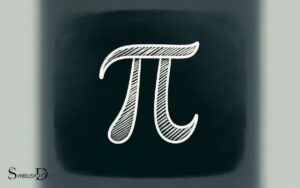Math Symbol for No Solution: Solutions!
The math symbol for no solution is the empty set symbol, denoted as ∅. This symbol is widely recognized in mathematics to indicate that a particular equation or set has no elements or solutions.
The ∅ symbol is crucial in mathematics, especially when dealing with equations and sets. It communicates the absence of any solution or element in a clear and concise manner, which is essential for the precision required in mathematical discourse.
- Example: If an equation such as x^2 + 1 = 0 is considered over the set of real numbers, the solution set is ∅, since no real number satisfies this equation.
- Bullet Point: The ∅ symbol is not to be confused with the Greek letter phi (Φ, φ), despite their visual similarity.
The ∅ symbol serves as a pivotal tool in mathematics, streamlining communication and avoiding ambiguity in problem-solving.

Key Takeaway
The Meaning of ∅ in Mathematics
The symbol ∅ in mathematics represents the empty set, indicating a set that contains no elements. It is a fundamental concept in set theory and has applications across various mathematical disciplines.
The empty set is unique in that it is the only set with no members, and its existence is a foundational principle in mathematics. It is denoted using the symbol ∅ or by { } with no elements inside the braces.
The empty set has important properties, such as being a subset of every set and having a cardinality of zero.
Understanding the concept of the empty set is crucial in various mathematical proofs, logic, and theoretical computer science.
Its significance lies in its ability to represent the absence of elements within a set, serving as a cornerstone in mathematical reasoning and analysis.
Representing No Solution With the Empty Set Symbol
In mathematical notation, the symbol ∅ is employed to represent the absence or non-existence of a solution. When encountering this symbol in a mathematical context, it conveys the concept of a solution set being empty.
This can occur when a system of equations has no common solution, or when the solution set of an inequality is empty.
The use of the empty set symbol can provoke a sense of frustration or confusion for individuals encountering it for the first time. It may evoke a feeling of curiosity or intrigue as to why a particular problem has no solution.
This symbol can also elicit a sense of challenge, prompting individuals to explore alternative methods or approaches to find a solution where it seems none exists.
Applications of the Empty Set Symbol in Equations
The empty set symbol plays a crucial role in representing unsolvable equations, indicating that no solution exists within a given set of parameters.
Its significance extends beyond equations, as it holds a fundamental position in set theory, serving as the basis for defining various mathematical concepts.
The application of the empty set symbol illuminates the concept of absence and its relevance in mathematical reasoning, providing a foundation for exploring the nature of solutions within different mathematical contexts.
Representing Unsolvable Equations
One common application of the empty set symbol in mathematics is to represent unsolvable equations. When encountering unsolvable equations, it can evoke feelings of frustration and confusion.
It can be disheartening to invest time and effort into solving an equation, only to realize it has no solution.
This experience may elicit a sense of disappointment or discouragement, as it challenges our problem-solving abilities. Moreover, it can lead to a reevaluation of our approach and a quest for alternative methods.
Ultimately, encountering unsolvable equations serves as a reminder of the complexity and diversity of mathematical problems, prompting us to adapt and learn from the experience.
Importance in Set Theory
How does the empty set symbol play a significant role in representing unsolvable equations within set theory?
In set theory, the empty set symbol, often denoted as ∅, represents the set with no elements. This is essential when dealing with equations that have no solution.
When solving equations, particularly in systems of equations, the concept of the empty set becomes crucial.
If, after applying various mathematical operations and manipulations, an equation or a system of equations leads to an inconsistency or a contradiction, it signifies that no solution exists.
This is where the empty set symbol is employed to denote the absence of a solution within the set of possible solutions.
Understanding the role of the empty set symbol in representing unsolvable equations is fundamental in grasping the outcomes of mathematical problems within set theory.
No Solution in Set Theory: Understanding
An understanding of the concept of ‘no solution’ in set theory is fundamental to grasping the implications of empty sets in mathematical structures. It represents an essential concept in understanding the nature of solutions or elements within a set.
Consider the following emotional responses:
- Frustration: grappling with the idea of a set devoid of elements can be perplexing.
- Curiosity: the notion of a set with no elements sparks intrigue and invites further exploration.
- Clarity: understanding the significance of the empty set brings a sense of enlightenment.
- Appreciation: recognizing the role of ‘no solution’ in set theory enhances one’s appreciation for the intricacies of mathematics.
Understanding the concept of ‘no solution’ in set theory is pivotal for comprehending the role of the empty set in mathematical structures and will further illuminate its significance when using ∅ in algebraic expressions.
Using ∅ in Algebraic Expressions
The symbol ∅, representing the empty set, plays a crucial role in algebraic expressions. It is commonly used to denote the absence of solutions in equations and inequalities.
Furthermore, ∅ has significant applications in set theory, providing a powerful tool for representing and manipulating sets in various mathematical contexts.
Representing Empty Sets
The symbol ∅ is used in algebraic expressions to represent an empty set. When working with empty sets in algebra, it’s essential to understand their significance and how they impact mathematical operations.
Here are some key points to consider when representing empty sets:
- The empty set symbol (∅) conveys the absence of elements, signifying a unique and important concept in mathematics.
- Utilizing the symbol ∅ in algebraic expressions helps to denote scenarios where there are no solutions or elements that satisfy a given condition.
- Understanding the representation of empty sets is crucial for solving equations and inequalities, as it enables clear communication of the absence of viable solutions.
- The use of ∅ in algebraic expressions facilitates precision and clarity in mathematical notation, aiding in accurate problem-solving and analysis.
Use in Inequalities
Using the symbol ∅ in inequalities serves to indicate the absence of solutions or elements satisfying the given conditions, playing a pivotal role in precise mathematical representation.
In algebraic expressions, when solving inequalities, the symbol ∅ is employed to denote that there are no values of the variable that satisfy the given inequality.
For instance, in the inequality x^2 + 1 < 0, the solution set is represented by ∅ since there are no real numbers that can be squared and then added to 1 to result in a negative number.
This concise representation using ∅ allows for clear communication of the absence of solutions in the context of inequalities, aiding in the accurate and unambiguous expression of mathematical concepts.
Set Theory Applications
Set theory applications frequently utilize the symbol ∅ to represent the absence of elements in algebraic expressions.
This symbol plays a crucial role in conveying the concept of empty sets and no solution in various mathematical contexts.
In algebraic expressions, the symbol ∅ is employed to denote the absence of solutions or elements, providing a clear and concise representation of such scenarios.
Understanding the applications of ∅ in algebraic expressions is essential for grasping the fundamental principles of set theory and its relevance in mathematical analysis.
- Clear representation of empty sets
- Precise indication of no solution
- Essential in conveying absence of elements
- Fundamental in set theory applications
The Significance of ∅ in Mathematical Notation
The symbol ∅ holds significant importance in mathematical notation, representing the concept of an empty set. In set theory, a set is a collection of distinct elements.
When a set has no elements, it is referred to as an empty set, denoted by the symbol ∅. This notation allows mathematicians to express the absence of elements within a set.
The concept of an empty set is fundamental in various mathematical principles, such as in the definition of a universal set, complement of a set, and the foundation of the null set in formal logic.
Moreover, the symbol ∅ plays a crucial role in representing the absence of solutions in various mathematical equations and systems.
Its significance lies in its ability to succinctly and precisely convey the absence of elements within a set, providing a foundational concept in mathematical notation.
Conclusion
The symbol ∅ in mathematics represents the concept of no solution, often used in algebraic expressions and set theory. Its significance lies in its ability to denote the absence of a solution or element within a mathematical context.
Just as a blank canvas symbolizes the potential for creativity and expression, the empty set symbol ∅ represents the absence of a solution, prompting mathematicians to explore alternative methods and approaches to problem-solving.






